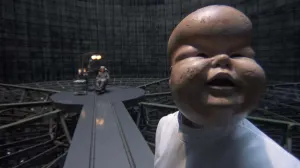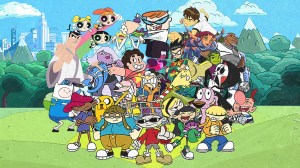
Empress #1, the newest Millarworld series, premieres this week at comic stores everywhere and on digital platforms like Comixology. It tells the story of Emporia the wife of a high-tech dictator in Earth’s ancient past who’s fleeing her husband in order to protect their children and escape the violence of his reign. We’ve had a chance to take a look at the first two issues and they are a splendid combination of a new, beautifully presented science fiction universe, stunning action sequences, and compelling family drama striking at universal themes. That’s no surprise coming from this creative team though.
Videos by ComicBook.com
Every person contributing to Empress is a modern comics all-star, and we had the opportunity to speak to each of them at ComicBook.Com. Follow along as we ask 10 questions to everyone who helped make this stunning new debut what it was, finding out how it came to be and what to expect next.
Mark Millar – Writer
1. There’s a very broad understanding of what writers in comics do, but everyone has their own unique style and approach. You’ve said before that you’re very detail oriented from the beginning. With that in mind, what was your process for writing Empress like and how does that position you within the team?
Mark Millar: It’s exciting in the sense that you’re the blank piece of paper guy. It can go anywhere at this stage and your only limit is your own imagination. I developed a new style 3-4 years ago where I started blocking out the entire arc before I started writing one page and it’s an enormous help. Freelancers rarely have time for this as most people are on the daily grind of several monthly books and so spending four weeks just thinking and playing around with post-it notes seems like a terrible luxury, but I do it now and would recommend it to everyone. It cuts down writing time after and has allowed me to jump from around 18 books a year to 21 books a year when my overall writing time has been limited by producer work.
2. Each collaboration is unique as well and you work with a lot of very talented artists on the Millarworld line. What has the process working with Stuart Immonen been like and what initially attracted you to working with Immonen on Empress?
Millar: I’m incredibly lucky with the art I get every morning these days. I honestly feel impossibly spoiled. Frank Quitely, Greg Capullo and Stuart Immonen are my guys at the moment and I feel like I’ve lucked out somewhat. I select each artist based on the type of material they’re drawing and for Empress I needed someone who was very good at making the fantastic seem very grounded and credible, but at the same time having just enough cartoonishness to carry the humour. realism sometimes loses the humour, but Stuart’s a lot like Neal Adams in that there’s a brilliant cartoonist at the basis of everything and he was perfect for this. Capullo’s project, as you’ll see in May when we release the cover and the title and the synopsis, is perfectly suited to his strengths too. It’s all about finding the thing an artist seems to enjoy doing. I want my partners on these Millarworld books having a good time.
3. Moving back to the story, where did the inspiration from Empress stem from? What made this the next project you had to do at Millarworld?
Millar: Empress actually came from a chat with a pal of mine who helps run the Millarworld boards. He was talking about how much he liked Starlight and how there’s pretty much no sci-fi anymore that’s aimed at a general audience. He was absolutely right. Since 1980 every director has tried to be Ridley Scott. Flash Gordon was the end of one thing and Alien the beginning of another. It’s very interesting because we always think Star Wars shifted cinema, but in reality it was Alien and maybe even moreso with Blade Runner. The latter wasn’t a financial hit like Star Wars, but it sparked something in directors and writers. As much as I love it, Empress is the antithesis of dystopian sci-fi. Millarworld has been veering more sci-fi in the last few years with Chrononauts too and even Huck when you see what it’s all about. There’s plenty of superheroes. Sci-fi just seems to be where my head is right now.
4. Both with Empress and Starlight preceding it, you’ve pulled from classic science fiction motifs to create brand new universes. Even in a book like Jupiter’s Legacy you’re constructing a very big world, even if it’s centered on Earth. As you continue in your career what appeals to you about this sort of world building in comics?
Millar: I’ve really always done it, to be honest. I wouldn’t be especially interested in writing an X-Men book and trying to navigate around the thousand stories that created that world, which is why I did Old Man Logan. I wasn’t interested in writing the sixth Superman title in a given month and so pitched Red Son, building it all from scratch. Even Ultimates I got to just do what I wanted with the very basics of the Marvel Universe. So creator-owned felt very natural as continuity is the mess that gets in the way of all good stories. Creator-owned works so well because it feels much like comics probably felt in 1941. Anyone can read them.
5. When designing an enormous science fiction world like the one in Empress there’s a lot of details that have to be considered from how an ancient (but advanced) society on Earth would look to what people across the galaxy would wear. How do you go about conceiving a complete setting essentially from scratch and does that change as new collaborators join?
Millar: I have some basic ideas which I pass along to Stuart, but he doesn’t need my advice when it comes to design and so he’ll happily jettison and do something a million times better. I usually have a very clear idea in my head of what a character looks like and drive artists mad at the design stage as we go back and forth until it clicks, but Stuart just nailed these guys so much better than I could have and seeing his drawing of the Queen’s bodyguard (Captain Dane Havelock) completely changed the way I wrote him. In my head, he was a little bit more reckless and more of a trouble-maker, clean-shaven and slightly swaggering. But when this much more formal looking guy came back with the very neat beard he became something else and I completely changed the way I wrote him. He’s more formal and uptight, slightly stiff but utterly, utterly brilliant at what he does. I think this is the first time a character sketch has ever had my change the personality of the character. He just seemed to come alive and I had to go with it.

6. The thing I am most enjoying about Empress is that even though it’s big sci-fi, the story is all about these very human characters and relatable conflicts. How did you go about crafting this family and figuring out who they are?
Millar: As pretentious as this sounds, they just kind of emerge. I sit drawing these guys for days and then they all come through. Emporia, the Queen, was the first and then I built the others around them. They had to feel like a real family and I knew I wanted a teen daughter who suspected she was leaving the father for the bodyguard and the gentle son was important as he’s a big reason the mother’s escaping and I wanted a baby too as I like babies. I’ve had three of them. On the run with kids adds a whole dynamic to a space adventure and I’ve always loved that Lone Wolf and Cub thing of a warrior with a baby on their back.
7. The family in Empress may be fantastical in design, but their conflicts are based in a reality we can understand. Abuse and divorce are right at the center of this story. What difficulties did you encounter in tackling these challenging topics?
Millar: Actually, that’s not a direction we went as the story is very much aimed at a general audience. The bad guy in this, Morax, rules ancient Earth and he utterly adores his wife and children. He’s not abusive to them in any way and actually has this strong streak of morality when it comes to his family and doing the right thing. The idea is more than she’s now in her late thirties and realises that all the things he does which keeps them in their incredible lifestyle is just unforgivable and she realises that by carving out what she thinks was a nice future for her kids she’s actually doomed them to inherit this guy’s appalling mantle. Her son is a lovely, gentle kid and she’s especially worried about how he’d cope, but the big thing is that she just wants them to have a normal life. It’s a bit like Carmella Soprano in that when she was nineteen this all seemed very glamorous, but the reality of it all has been growing on her and as she hits her late thirties she comes up with a plan.
8. The children play a very active role in the story, helping to solve problems and maybe causing some of their own. How has being a father changed how you address and write young people in your stories?
Millar: I constantly seem to be having children so I’m constantly engaged with them and what they’re into as toys or on TV. But I also remember how much I liked seeing capable kids in comics and movies and TV shows as a wee boy. I really liked Superboy because he was able to take on adults and beat them like Superman would. Likewise Robin and the Teen Titans. My absolute favourite books when I was ten were The 3 Investigators and I even started my own, short-lived detective agency based around it. Kids love to read about other kids solving problems. It’s the wish fulfilment thing with any heroes, but somehow one step closer.
9. Emporia is both a powerful and very engaging lead character. There’s no doubt from the first issue that Empress is her story first and foremost. This is the first time, besides Hit-Girl, that a Millarworld comic has featured a woman as its leading protagonist. What compelled you to shift your focus from male-driven stories to having a wife and mother as the hero here?
Millar: Actually, Jupiter’s Legacy has a female lead. We meet both protagonists early on, but by issue 3 we realise the story is all about Chloe and that’s another hero mother story. Empress was next and the Greg Capullo project is a female lead, as is the upcoming Johnny Romita project we’re talking about for next year. It wasn’t a conscious decision. You just write what feels right and to be honest the idea of a great new white male lead doesn’t seem especially radical or needed right now. There’s lots of what male leads. That market seems to have been taken care of pretty well for the moment so it’s just interesting. Starlight was about an old man who had nothing left, Hit-Girl is about a ten year old girl. It’s just fun to mix it up a bit and tell different kinds of stories.
10. One last thing: To give our readers a look at Empress and your role on the creative team, would you mind sharing a section of the script and the final comic, and speaking to what you enjoyed about crafting that moment?
Millar: Sure. This opening page actually came to me about five years ago when I was in the Natural History Museum in New York and read this very fact about the human race. At that very moment I knew I wanted to tell a story about ancient, pre-human Earth and the people who lived here before us. That perspective on the short time we’ve been here just felt awesome in the traditional sense of the word. The next sequence sets up the threat and I quite like stories where the threat is introduced before the heroes because this way we feel the stakes immediately. I wanted to show the enormity of what the heroes were going to be up against and in the smallest number of words and pictures establish not just his personality, but the world he inhabits and how he’s basically in charge on billions and they’re just a little gang on their own.
Empress is available April 6, 2016 from physical and digital retailers of comics.
Check Out More Interviews From Empress Week Below:








